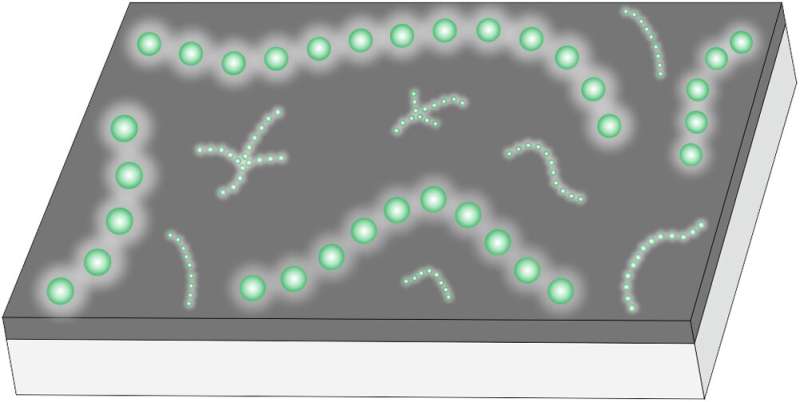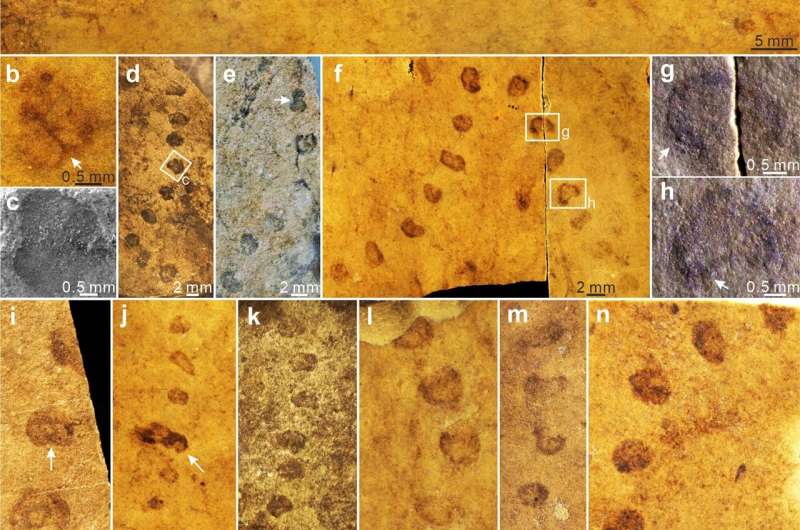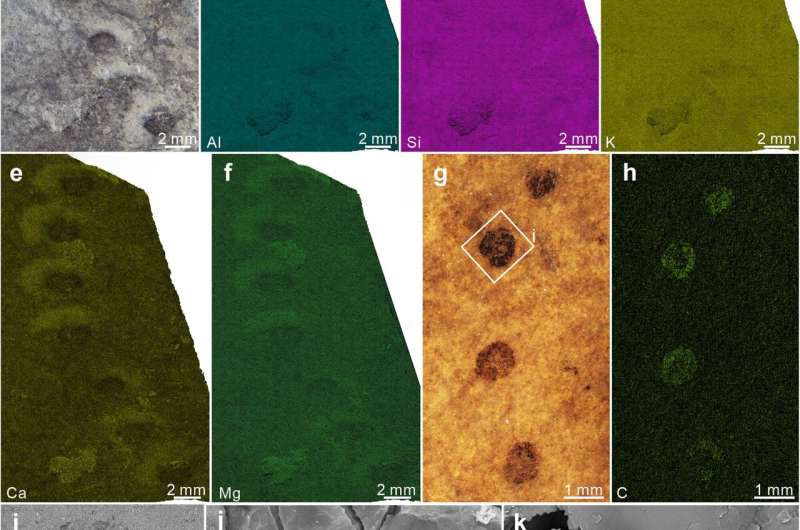This article has been reviewed according to Science X's editorial process and policies. Editors have highlighted the following attributes while ensuring the content's credibility:
fact-checked
peer-reviewed publication
trusted source
proofread
Horodyskia is among the oldest multicellular macroorganisms, finds study

Horodyskia, characterized by a string of beads with uniform size and spacing, is a kind of macroscopic fossil with a record extending from the early Mesoproterozoic Era (~1.48 Ga) to the terminal Ediacaran Period (~550 Ma).
Now, researchers led by Dr. Li Guangjin and Prof. Pang Ke from the Nanjing Institute of Geology and Palaeontology of the Chinese Academy of Sciences (NIGPAS) and Prof. Chen Lei from Shandong University of Science and Technology have revealed that Horodyskia is among the oldest multicellular macroorganisms and may have attained its macroscopic size through a combination of coenocytism and simple clonal coloniality.
The study was published in Communications Biology.
Proterozoic macroscopic fossils are crucial for understanding the early evolution of eukaryotes, particularly how and when early eukaryotes developed complex multicellular grades of organization and acquired body sizes that are visible to the naked eye.
One of the prominent features of Horodyskia in previously reported specimens is the cast-and-mold preservation in fine-grained siliciclastic rocks or in cherts (silicification), with no evidence for the preservation of organic walls. This feature further impedes the biological and phylogenetic interpretation of Horodyskia.

The new Horodyskia specimens in this study, from the Tonian Shiwangzhuang Formation (~850–720 Ma) in western Shandong and the Jiuliqiao Formation (~950–720 Ma) in North China's Huainan region, are unique in their diverse preservation styles, including carbonaceous compressions, three-dimensionally preserved organic-walled fossils, shallow impressions, and casts and molds.
The carbonaceous nature of Horodyskia fossils, similar to representative carbonaceous compression macrofossils from the Shiwangzhuang Formation, suggests an underlying biological origin. Importantly, the carbonaceous compression specimens and three-dimensionally preserved organic-walled specimens are similar in morphology and size, strongly disputing the possibility of sedimentary structures, mud flocs, or intraclasts.
Raman spectroscopy reveals that the carbonaceous material of the Shiwangzhuang Horodyskia specimens have spectral characteristics similar to coexisting multicellular fossils, indicating that they both experienced low-grade metamorphism with similar peak metamorphic temperatures. Given the presence of possible compressional folds and three-dimensional preservation, the Shiwangzhuang and Jiuliqiao specimens suggest that Horodyskia beads are bona fide fossils with organic-walled vesicles.
Two groups of fossils with distinct bead sizes were observed on the same bedding plane in the Shiwangzhuang Formation. They have the same preservational style, exhibit similar positive correlations between bead diameter and spacing and between bead diameter and distance, and share a largely overlapping chemospace distribution, suggesting that they are not only biogenic, but also likely congeneric organisms.
The ranges of their bead diameters overlap with that of Horodyskia minor from the Liuchapo Formation and that of H. moniliformis from the Appekunny Formation, respectively, supporting the assignment of specimens with submillimetric beads to the genus Horodyskia. These findings suggest that Horodyskia has a stratigraphic range from the early Mesoproterozoic to the late Ediacaran, with remarkable long-term morphological stability over 900 Myr.

Overall, Horodyskia can be reconstructed as a chain-like organism or a colony of individuals composed of several to dozens of vesicles or cells with a recalcitrant organic wall and likely embedded in an amorphous gelatinous matrix. The observed division in beads and paired beads likely resulted from binary fission and indicate that the submillimetric to millimetric beads of Horodyskia very likely represent giant cells. Horodyskia cells are orders of magnitude larger than typical prokaryotic cells, and their inferred large-sized recalcitrant cell walls are unusual for prokaryotic cells. Therefore, Horodyskia is unlikely to be a prokaryotic organism.
"The large cell size of Horodyskia indicates that it is not only a eukaryote, but also likely a multinucleated or coenocytic eukaryote," said Prof. Pang. "The submillimeter- to millimeter-sized cells of Horodyskia seem to require multiple nuclei to regulate the giant mass of cytoplasm."
The cellular nature and the unconnected, but occasionally dividing, feature of Horodyskia beads, indicate that these fossils are unlikely to be complex multicellular organisms, but are more likely to be protists whose clonal cells formed simple and not fully integrated colonies (i.e., simple clonal coloniality).
Protists with simple clonal coloniality construction, a submillimetric to millimetric cell size (or inferred coenocyte), and a recalcitrant cell wall—features that define Horodyskia—are limited to a smaller number of eukaryotic clades. This study evaluated the three most likely potential analogs: arcellinid testate amoebae, foraminifers, and some algal groups, all of which have been proposed in previous studies.
The most plausible phylogenetic interpretation for Horodyskia is that it represents a multicellular, giant-celled protist, which has acquired a large body size and shares some similarities with living coenocytic algae and monothalamid foraminifers, although the latter are typically unicellular and therefore less comparable. Together with other possible early-middle Proterozoic coenocytic fossils, Horodyskia provides an important temporal constraint on the origin of coenocytic eukaryotes.
More information: Guangjin Li et al, Tonian carbonaceous compressions indicate that Horodyskia is one of the oldest multicellular and coenocytic macro-organisms, Communications Biology (2023). DOI: 10.1038/s42003-023-04740-2
Journal information: Communications Biology
Provided by Chinese Academy of Sciences





















